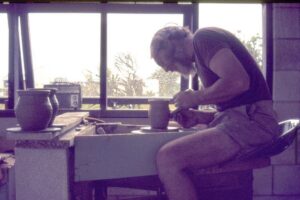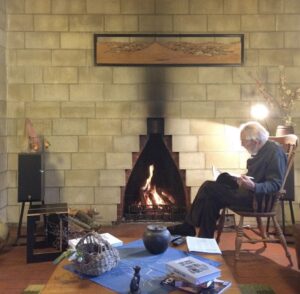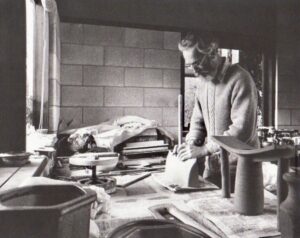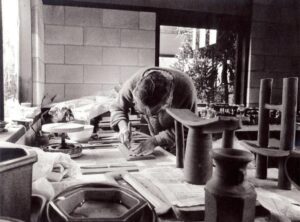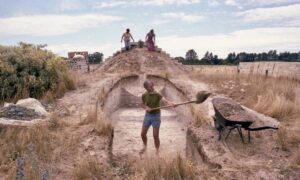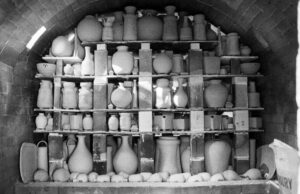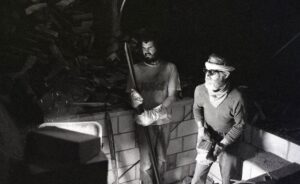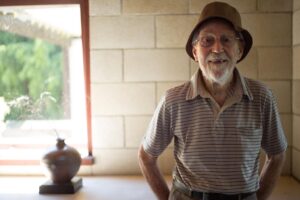Your cart is currently empty!
In memoriam: Bruce Martin

Ceramics NZ Life Member, Bruce Martin, passed away on the 21st of June 2023, at the grand age of 97. Unable to find vessels suitable for his wife, Estelle’s, ikebana arrangements in 1960’s Hastings, Bruce suggested they make their own. So began a 40 year partnership in pottery making.
From humble beginnings in the backyard of their Pakowhai Road property – with a kiln made out of recycled bricks and an old vacuum cleaner – Bruce and Estelle initially made practical and useful domestic ware. Originally materials used for glazes were collected on family outings with their three boys, from local riverbanks and fruit orchards. Marooned in provincial New Zealand, they made do with books and the occasional visiting tutor to learn the craft. One of these tutors, Peter Stichbury, along with his wife, Diane, became lifelong friends.
Eventually, Bruce and Estelle opened a small shop on Karamu Road and established stockists around the country. Soon they were able to sell enough for Bruce to give up his work as a radiographer and, together with his wife, pursue potting full time. Bruce and Estelle displayed their work at craft shows and annual exhibitions, all the while expanding networks and knowledge.
Having outgrown their suburban workshop, in 1968 Bruce and Estelle purchased a 10-acre block of bare farm land at Bridge Pā, on the outskirts of Hastings. They commissioned a local architect, John Scott, to design a house and workshop for the property, now recognised as a Category One Historic Place. Scott later designed a bush house near Hokitika for Bruce and Estelle, somewhere they could get away from the hot Hawke’s Bay summers, which Bruce then built himself. He had a talent with wood and photography, as well as clay.
In 1978 Bruce and Estelle finally traveled to Japan to pursue their interest in traditional Japanese ceramics, visiting potteries and museums and meeting Japanese potters and collectors. Inspired, on their return to Hastings they built a customary Japanese-style anagama kiln. The photos of Bruce digging the enormous kiln are evidence of the lengths they were willing to go to in pursuit of their craft. The kiln could hold around a thousand pots. Each anagama firing lasted up to 10 days and took 25 or so tonnes of wood, which Bruce split himself, about two months’ work. He lost part of a finger in the process.
The first firing didn’t go as planned, the smoke chamber collapsed and the firing was cut short. It wasn’t a total failure, however; a lot was learnt. When they next fired the kiln, a Japanese master, Fuji Sanjo, also assisted them. Often the kiln firings involved routine but arduous shift work, with family and close friends pitching in. The kiln needed a new supply of wood every five minutes or so. Menus to feed the workers were meticulously planned by Estelle. It was hard going. The results were worth it, however, breathtakingly turned pots based on traditional Japanese forms with striking and unpredictable natural glazes produced by the ash in the kiln.
Bruce and Estelle continued to pot full time, firing the kiln once a year until, after ten or so firings and now entering their 60s, it became too much. Undaunted, in the 1990s Bruce and Estelle built a smaller kiln next to the larger one. This was fired for the last time in 2001, shortly before Estelle’s death.
After Estelle passed away, Bruce gave up making pots and sold his gear. He continued to sell pots, and share his skills and knowledge with those who were interested. He lived a quiet life on the property, tending to the garden, corresponding with his many friends, and traveling. Bruce made his last trip, a round the world odyssey, in his late 80s.
It was at this time that the archival work also began. There was a retrospective exhibition and a new generation of admirers were won over. Peter Shaw’s book from the retrospective exhibition – ‘Kamaka: The Ceramics of Bruce and Estelle Martin’ – is a great starting point. Bruce’s home remains filled with craft treasures, bought or traded with friends over a lifetime, many of them still in use. The best anagama pieces are on display in the recently curated workshop/gallery space, a place dedicated to the beauty, skill and monumentality of their work.
Bruce’s life was lived thoughtfully and intentionally, but was largely the result of an immense amount of labour, learning and risk taking. Bruce left his home for the last time on the 27th June, surrounded by family, friends and collaborators.
Ceramics New Zealand would like to thank Frances Martin for graciously contributing this article.
Frances welcomes enquiries for studio/kiln visits and also has copies of Peter Shaw’s book / catalogue available. Email Frances directly to enquire.
Watch a video ‘Firing the large Kamaka anagama’
Images below used with permission of the Martin family, except portrait by Richard Brimmer, used with his permission.

